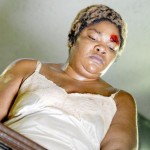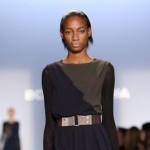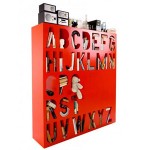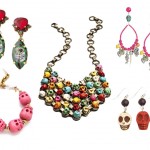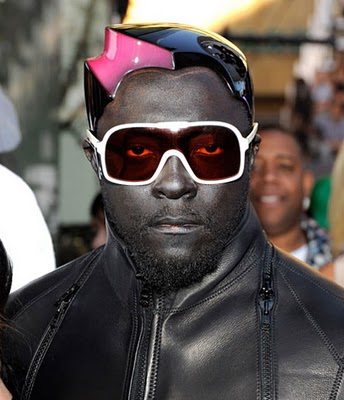 Fashion stuntwoman Lady Gaga is no stranger to controversial red carpet attire designed for the gossip mill, but even the provocateur pop queen’s meat gown at the recent MTV Awards couldn’t compete with the Black Eyed Peas’ Will.i.am’s wardrobe decision. For a futuristic performance at the pre-show, Will.i.am opted to take Jay-Z’s ‘All black everything’ mantra literally, donning head-to-toe leather and painting his face black, thereby performing a kind of inverse, 21st-Century minstrelsy, and raising the question: Is it possible to sever blackface from its hate-filled history?
Fashion stuntwoman Lady Gaga is no stranger to controversial red carpet attire designed for the gossip mill, but even the provocateur pop queen’s meat gown at the recent MTV Awards couldn’t compete with the Black Eyed Peas’ Will.i.am’s wardrobe decision. For a futuristic performance at the pre-show, Will.i.am opted to take Jay-Z’s ‘All black everything’ mantra literally, donning head-to-toe leather and painting his face black, thereby performing a kind of inverse, 21st-Century minstrelsy, and raising the question: Is it possible to sever blackface from its hate-filled history?
Before he could even step off the stage, the Twitterverse was flooded with tweets questioning Will.i.am’s decision to perform in blackface, some choosing to defend him by implying that it’s the intent behind the blackface that matters. Will.i.am responded to his critics by tweeting: “just because I where (sic) all black including head mask as expression and emphasize my outfit, it shouldn’t be looked at as racial… Let go of the past.”
Will.i.am is not alone in flirting with the implications of blackface in the name of being provocative, edgy, and artistic. Estelle did it in her video for “Freak,” and so did Rihanna in her “Rockstar 101” clip. Even fashion glossies, which have been criticized for their lack of diversity, have brazenly taken to painting white models black for editorials. The resurgence of once-taboo blackface is now being touted as a form of artistic expression, by both the pop culture and fashion communities alike. Not everyone’s buying it.
No matter how experimental, blackface remains haunted by its profoundly racist past
Made famous by Thomas D. Rice, blackface minstrel shows were conceived in 1830 when Rice, a white, New York-based actor, dressed up in rags, blackened his face, and performed a song and dance routine about an escaped slave called Jim Crow. Soon after, white performers began smearing burnt cork on their face to mock and demean African-American life by portraying them as dirty, stupid, and happy-go-lucky. Talented black performers like Bert Williams, Paul Robeson, and even Josephine Baker were forced to perform in blackface if they wanted to grace a stage at all. “For those who don’t think its blackface when you are black are highly mistaken,” says Howard University’s Graduate Professor of Mass Communications and Media Studies, Dr. Clint C. Wilson II, referring to when Estelle defended her choice to wear blackface by pointing out that she’s black. “Bert Williams made his career as a black artist in blackface. He was the most prominent black entertainer for the first 20 years of the 20th century. He was terribly conflicted by his blackface acts. For somebody to come along 100 years later and say they are being creative…At least Williams’ excuse was that that’s the way it was done back then. What excuse do you have now?”
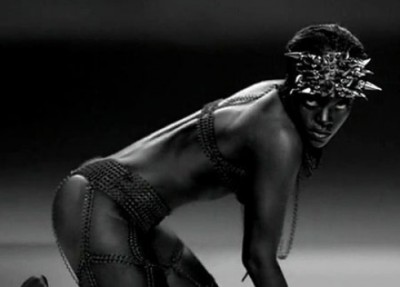 While Peniel E. Joseph, award-winning author and Professor of History at Tufts University, doesn’t believe Will.i.am intended to put on a minstrel show, he does point out that the Grammy winner, “is emblematic of a new generation that doesn’t feel as connected to historic symbols of racism and don’t really have an understanding of the history. There is this resurgence of white supremacy groups and economic anxiety, and these are all connected whether Will.i.am sees it or not,” he says.
While Peniel E. Joseph, award-winning author and Professor of History at Tufts University, doesn’t believe Will.i.am intended to put on a minstrel show, he does point out that the Grammy winner, “is emblematic of a new generation that doesn’t feel as connected to historic symbols of racism and don’t really have an understanding of the history. There is this resurgence of white supremacy groups and economic anxiety, and these are all connected whether Will.i.am sees it or not,” he says.
The question remains, can today’s black performers succeed in disconnecting blackface from its larger historical context? Is nixing minstrel show’s iconic white gloves and freakish red or white drawn-on grins enough to preclude blackface as an act of racism?
“They may see this as an attempt to showcase their artistry while at the same time trying to make a statement out of turning a negative of the past as a tool of empowerment,” says Alistair Feathersone, a 32-year-old Investment Banker who says he does not find a black person wearing blackface offensive.
“Blackface can come up in these slightly altered forms. There is one (form) that makes a literal historical reference and then there’s the postmodern pastiche where people dress up in blackface and it references other things. I mean, we’d all like to live free of historical context, but that’s not the case. To me, Will.i.am looked kinda sci-fi,” says Ed Guerrero, a professor of Cinema Studies and Africana Studies at New York University, who’s currently writing about the topic. “You know what the new meaning of blackface is?” asks Chuck D of Public Enemy. “It’s about how to keep my record contract and stay popular. Sometimes you have to make some black judgment calls that benefit the people as a whole. What is happening with black entertainers is that it’s okay to know less about your history. The problem comes when someone knows more than you do about your own history.”
The question remains, can today’s black performers succeed in disconnecting blackface from its larger historical context?
Whereas the blackface of the past was rooted in maintaining stereotypes that have gone on to survive the minstrel show era, some members of the fashion world see it as a sort of post-racial homage to diversity. But with no real statement being made or dialogue occurring in response to such images, there’s plenty of room for interpretation – and some can be distressingly naive. “I loved the V magazine editorial where a painted Sasha Pivovarova was embracing a white Heidi Mount. I thought the message was love and unity, but people are so wired to look at things in a negative way,” reveals an anonymous stylist.
While Vogue Italia writer and fashion blogger Claire Sulmers sees nothing wrong with Rihanna, Will.iam, and Estelle using blackface to express themselves, she finds white models in blackface questionable. “Face it. There is a double standard when it comes to this. As much as we’d like it to not be, there is still a lot of racial tension in America and around the world. The fashion industry is already elitist, and there is a lack of people of color anywhere, so to juxtapose that with these models in blackface is disturbing.”
If there’s one thing that’s apparent in the debate over what constitutes blackface today, it’s that no matter what Will.i.am or French Vogue’s version of the future looks like, some historical symbols can never escape their ugly past, no matter how you dress them up.
Link
Blackbookmag.com – What Place Does Blackface Have in Popular Culture?
- Write of Passage - October 28, 2013
- Old School Mood Boards - June 17, 2013
- Chloe Resort 2014 - June 12, 2013


